Cold Packed Cucumber Dill Pickles
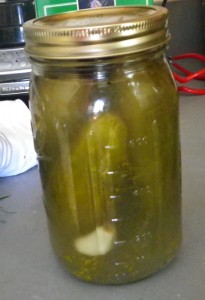 I love this pickle recipe, because I can make a jar as I pick cucumbers instead of saving cucumbers until I have a lot and doing a mass canning. I also love this because it’s relatively effortless.
I love this pickle recipe, because I can make a jar as I pick cucumbers instead of saving cucumbers until I have a lot and doing a mass canning. I also love this because it’s relatively effortless.
The first thing you have to do is sterilize the jars. This is important because you aren’t going to be applying heat to the process, so this is your chance to kill any bacteria on the surface of the jar. First wash them in hot, soapy water, then rinse them and put them in a pan big enough to cover the jars with water. Bring the water to a boil, and boil them for 20 minutes. Leave the jars in the hot water until you’re ready to use them.
One other thing you need to do to prep: One of the items in this pickle is a clove of garlic. There is a bacteria common in the onion family, which can cause spoilage. To protect against this, bring a small pot of water to boil. Peel your garlic cloves and plunge them into the boiling water for one minute then remove. The clove is now safe to use.
You want about 4-inch cucumbers. For each jar, you’ll need as many cucumbers as will fit in the jar. That’s usually about 5 of them.
Wash your cucumbers really well. Cut the ends off, especially the end where the stem was. (If you leave the stem on, the pickles can end up mushy.)
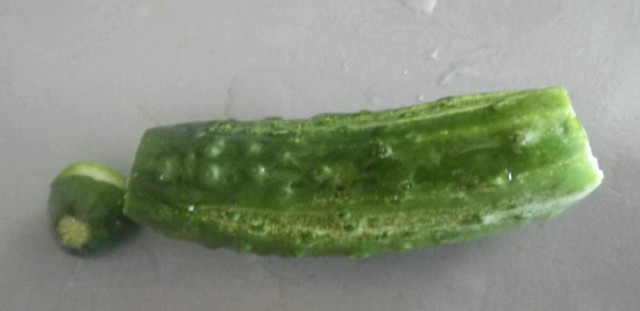
In the bottom of each sterilized jar, place:
1 rounded Tablespoon of rock salt or canning salt
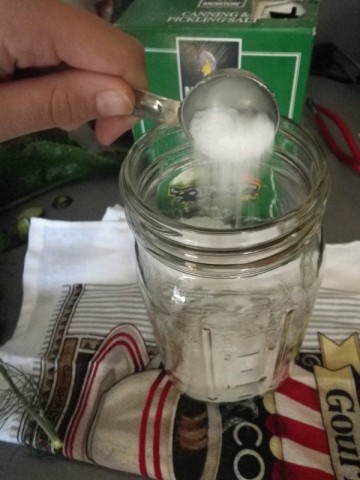
1 large grape leaf or horseradish leaf (I use horseradish leaves) (washed well)
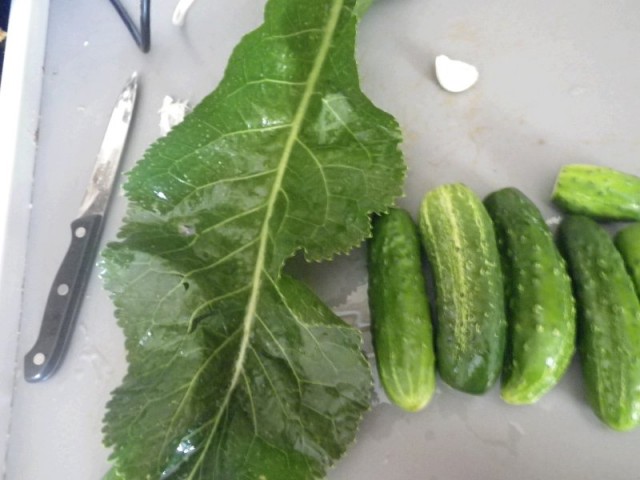
1 to 2 dill heads (washed well)
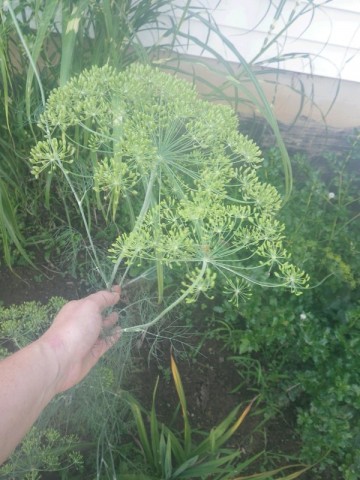
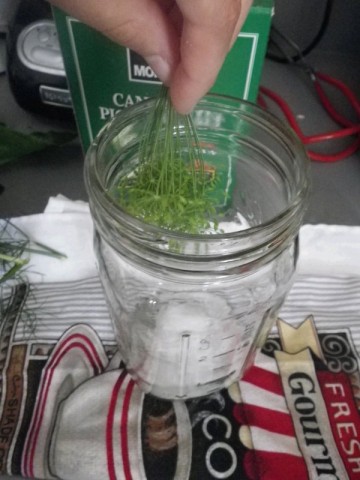
1 clove garlic
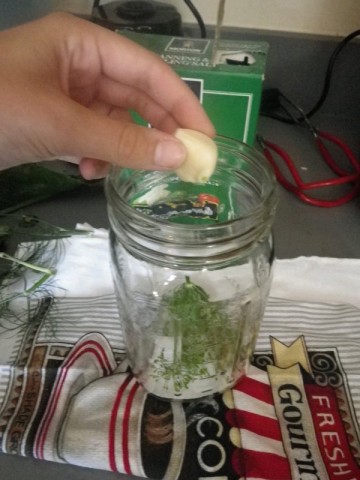
Once these items are in the jar, pack your cucumbers in. Reserve space in the top for more dill heads.
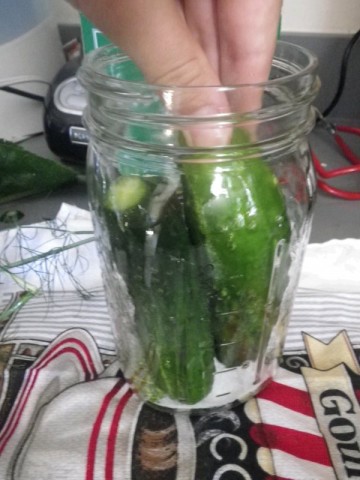
Fill with cold, filtered water.
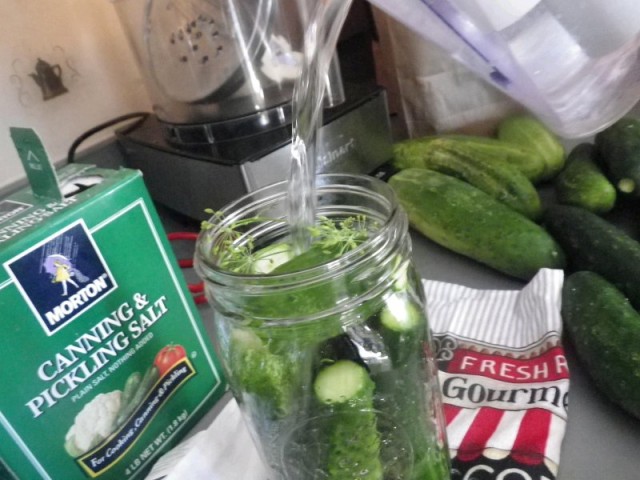
Place another dill head in the top of the jar. Wipe the lip of the jar off with a clean cloth and put the lid and band on the jar. Tighten.
Gently turn the jar up and down until the salt is dissolved.
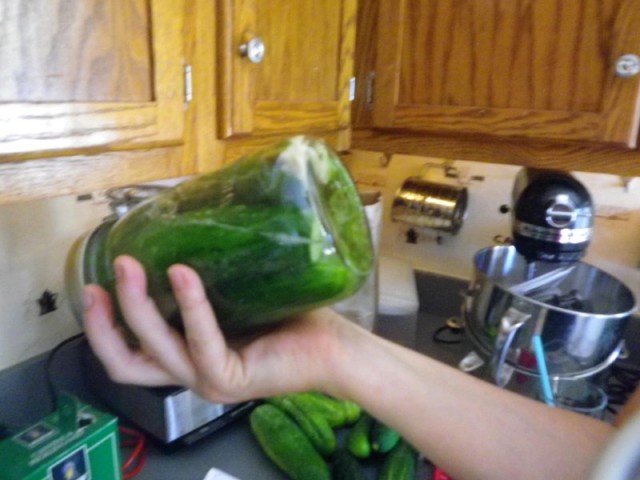
Store in a cool place.
The pickles will be ready in about 2 or 3 months.
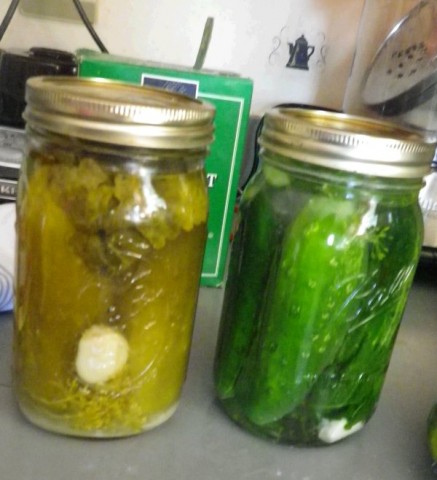
You may note some fermentation for a few days, which is natural for this method of pickling. If a jar runs over, wait until the fermentation is over, wipe the lip off with a clean cloth, and reseal.
Hallee
I’m so grateful for your visit, today.
You would bless me if you added me to your ![]() feed reader or subscribed
feed reader or subscribed  via email.
via email.
You can also become a fan on ![]() Facebook or follow me on
Facebook or follow me on ![]() Twitter. I would love to see more of you!
Twitter. I would love to see more of you!
This post was linked to:


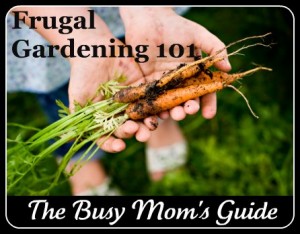


What a great idea! I’ve got one lonely pickling cucumber plant in my jungle of a garden, and I haven’t been doing anything with it because I couldn’t collect enough pickles.
Do all pickles have horseradish?
In the store? I don’t know. Probably not. There’s probably some chemical that does the same thing.
Kara — It’s a leaf.
According to the very old, very traditional recipes we consulted, you can use either a grape leaf or a horseradish leaf. We use the horseradish leaf because we have a monster sized horseradish plant and no grape leaves (yet!).
Best I can tell, the leaf helps in the fermentation process. No idea why or how.
Likely, store bought pickles use some industrial grade chemical to accomplish the same thing.
God Bless,
Gregg
I only wondered because I’m allergic to horseradish, and if most pickles have it, I need to be careful :)
They are super yummy!
I’m not a big pickle person but I always enjoyed canning with my mom :).
Hi there, Hallee. I’ve been chewing on this post since I read it. I’ve been trying to understand how the process works. So, here I am in the middle of the night, posting questions to your blog. (Yes, I spent my Friday night clipping coupons and thinking about canning pickles…wives of deployed husbands lead exciting lives…:-) ) So, here are my questions:
1: Does the jar actually form a seal as if you put it through the canner?
2. Do you have any idea how the process works? (I assume it’s fermentation, but what starts the process?)
3. I have concerns about botulisim, salmonella, and other nasties. Other than rigorous sanitation, are there ways to ensure that they won’t have a pickle party (the nasties, I mean)? I like to have parties, but these things are in general NOT invited. There seems to be a lot less salt than other recipies that I’ve seen, and no vinegar. These are preservatives that I am used to using.
4. Are the grape and horseradish leaves truly necissary? If so, I’m going to have to locate a source this year and plant a horseradish plant next year.
What I mean to say is that I am not familiar with this process, and I find it a little intimidating. I would be grateful if you would answer my questions. THanks for the thought-provoking post. And yes, I did just say that about your pickle recipe.
Kara,
.
What fantastic questions! Let me first give you some brain food that you can explore to the ends of your curiosity. That is the official USDA Complete Guide to Home Canning for all home canning and preserving. You’ll love it! You can also download the entire PDF in individual chapters. I would direct your specific attention to chapter 6. Honestly, reading through that entire guide, though, will very likely relieve any feelings of being intimidated by the prospect of canning or pickling. It is a wonderful resource and it’s free.
.
So, to your questions. It is a pickling process. Usually, fermentation or lacto-fermentation relies on bacteria or yeast and mainly is about transforming sugars. Pickling relies on, well, usually salt so it is a slightly different chemical reaction. We aren’t mainly transforming sugars and creating alcohols. We are chemically dehydrating with some mild fermentation as a side effect. As you will read, the USDA recommends cooking cold pack veggies up to between 140 and 185 F which is really an unnecessary extra step provided you get and keep everything really clean. However, if you are a serious germo-phobe, you can follow the USDA method which also calls for unnecessary vinegar (thus increasing fermentation) and involves hot canning upon completion. The traditional cold pack method is the one described above in Hallee’s recipe where everything basically remains at room temperature once it is sterilized but you have to use clean filtered water and you have to have clean hands and utensils and all of the veggies and such have to be clean or blanched. For literally millennia, people didn’t have the technology to heat or pressure can and seal, and they just brined everything, so the authors considered it another unnecessary step to heat seal and we agreed — especially after tasting the results.
.
Oh, and YES the jars seal and they should pop when you open them after a few months just as if you heat canned them.
.
Salt pickling, and salt preserving for that matter, as a means of storing food has been around for thousands of years — long before heat/pressure canning came about. In many cultures, salt was so desirable for use as a preservative that it was used for money.
.
How it works is like this. All organisms with a semipermeable cell membrane are subject to osmotic pressure, (the effect of water moving in and out of the cell). Bacteria have a cell membrane and a cell wall. Bacteria must live in an aqueous (watery) environment, usually a hypotonic environment, which is to say, the concentration of water outside the cell is greater than the concentration of water inside the cell. This causes the net movement of more water into the cell than outside. If the bacterium did not have a cell wall, this could cause the cell to burst.
.
So why does salt work as a preservative? Because when the outside environment around a cell is salty, then the concentration of water in the solution is less than inside the cell and water tends to leave the cell. This causes the cell to dehydrate, which eventually kills the cell. By subjecting bacteria to a salty environment, it keeps them from growing and kills existing bacteria.
.
With respect to the grape leaf or horseradish leaf, I can only tell you that the pickles from last year are super yummy. Not sure what role the horseradish leaf played in that but the very old, very traditional recipes we studied all called for one or the other and we have a horseradish plant so it was a no-brainer. If you have any vineyards in your vicinity, maybe ask if you can harvest a few dozen grape leaves? Can’t imagine they would say no, especially if you maybe offered them a jar of pickles in trade.
.
We want to start using grape leaves because Hallee wants to dive into making her own stuffed grape leaves soon. That will required pickled leaves. But our attempts at getting a grape arbor going for the last few years haven’t turned out for this or that reason. Her parents have some thriving grape arbors, though, so we are set if we remember to harvest some leaves this year.
.
God Bless you and all your loved ones,
Gregg
The grape or horseradish leaves contain tannins which help keep the pickles crisp. The modern equivalent is the chemical alum.
The salt is used to inhibit spoilage until the bacteria naturally present on the cucumbers produces enough lactic acid to preserve the pickles which has a similar sour taste as vinegar.
Where do you store your jars for the long period of time, last year to this year? Do you have a cellar or just in the basement? Can you give me a temp. range that is acceptable. I thought they had to be stored in the fridge.
These are preserved. They don’t have to be stored in the refrigerator. I just store mine in my basement.
Found this recipe last week and need some clarification.
1) can i use cuke slices, w/without rind?
2) if they ferment a little, do i need to leave the jar lids loose?
3) is seasalt okay instead of canning/picking salt?
I’m looking forward to trying this as i just made sauerkraut in a crock 2 weeks ago.
kathy
1). I don’t know. The spears I made were kind of mushy. Wouldn’t hurt to try.
2). Yes
3). Yes, you can.
Good luck! How did you sauerkraut turn out?
Mine get a sediment as well. It’s normal.
I made these pickles last week, and pulled them out today just to look. There is a white sort of sediment on the bottom of the jars. Is this normal? I made pint jars, not the quart that is show in the recipe, so I only used 1 1/2 tablespoon of salt. I hope this wasn’t a mistake.
I used 1/2 tablespoon in a pint jar, not 1 1/2!
I just opened a jar of the pickles I made a few weeks ago. They’re absolutely delicious.
Thank you so much!
I made the same basic pickle recipe from another website until i found yours. The recipe I used said to store the cold packed finished pickles in the fridg for 3 months. Now i have an issue. I had to move the pickles to a neighbors house for 3 weeks and she put them in her pantry instead. They appear to be ok. Are they safe to eat? Your reply to a similar question from a blogger stated that you just put them in your basement. If my pickles are safe to eat, i will be very happy. Thanks!
How is your recipe worded? Is it the same ingredients?
The pickles made in this recipe are safe to store in a cool, dry place. They don’t need to be refrigerated.
where do you buy horseradish leaves?
I’m not sure. I have a horseradish plant in my yard. Maybe check with a farmer’s market.
I love Christmas recipies!
I’m glad I found this site
I noticed you do not say anything about lids I am wondering boil or not and do you believe this would work with bigger pickles in 1/2 gallon jars?
Always thoroughly sanitize all of your supplies. I boil my lids and jars.
I have done it with the bigger cukes in 1/2 gallon jars, but I’ve not opened them yet to see how they turned out.
Have been using a recipe of my Mothers, and the Dills turn cloudy in a few days. Is this the fermentation? Hate to toss them, but won’t use if there is any danger eating them. Could you please give me some insight? Haven’t tried canning for almost 40 years. Thank you.
Were these cold pack or fermented?